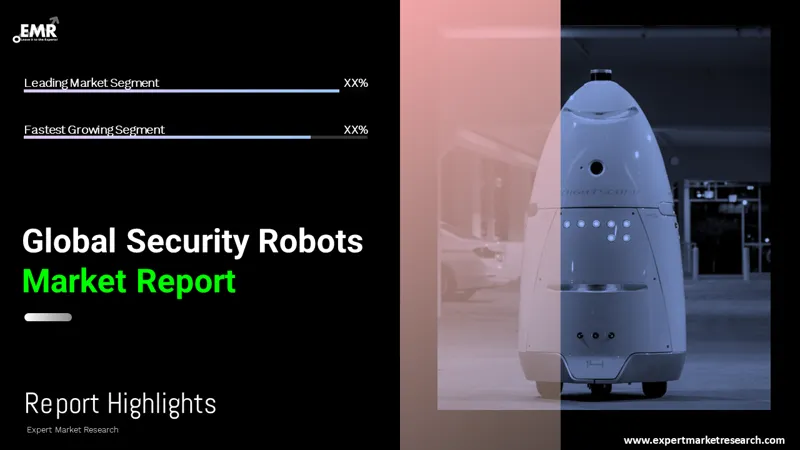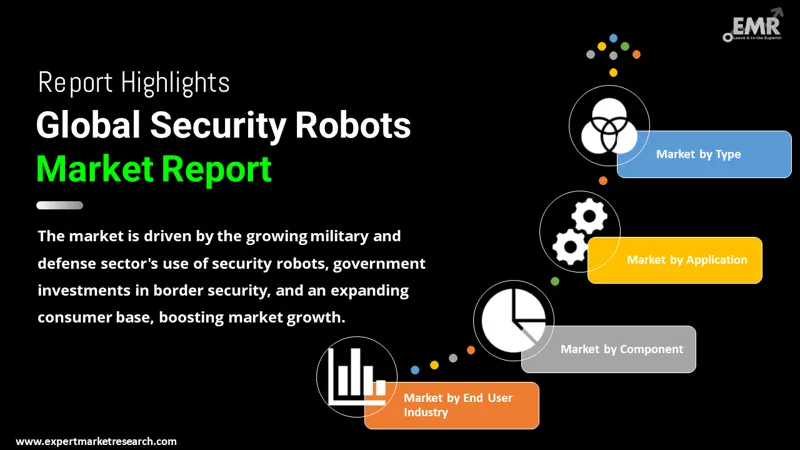
Consumer Insights
Uncover trends and behaviors shaping consumer choices today
Procurement Insights
Optimize your sourcing strategy with key market data
Industry Stats
Stay ahead with the latest trends and market analysis.
The global security robots market size attained a value of approximately USD 12.68 Billion in 2025. The market is further expected to grow in the forecast period of 2026-2035 at a CAGR of 12.80% reaching a value of around USD 42.29 Billion by 2035.
Base Year
Historical Period
Forecast Period
Compound Annual Growth Rate
12.8%
Value in USD Billion
2026-2035
*this image is indicative*
| Global Security Robots Market Report Summary | Description | Value |
| Base Year | USD Billion | 2025 |
| Historical Period | USD Billion | 2019-2025 |
| Forecast Period | USD Billion | 2026-2035 |
| Market Size 2025 | USD Billion | 12.68 |
| Market Size 2035 | USD Billion | 42.29 |
| CAGR 2019-2025 | Percentage | XX% |
| CAGR 2026-2035 | Percentage | 12.80% |
| CAGR 2026-2035 - Market by Region | Asia Pacific | 14.8% |
| CAGR 2026-2035 - Market by Country | India | 16.9% |
| CAGR 2026-2035 - Market by Country | China | 14.1% |
| CAGR 2026-2035 - Market by Component | Camera Systems | 14.6% |
| CAGR 2026-2035 - Market by End User Industry | Defence and Military | 14.3% |
| Market Share by Country 2025 | France | 3.3% |

Read more about this report - REQUEST FREE SAMPLE COPY IN PDF
Growing geopolitical instability, improvements in capabilities of security robots, and rising expenditure of various governments in security research and development are the major factors that are increasing the security robots market demand. The capabilities of security robots, such as their ease of deployment in hazardous situations and shifting terrains for the performance of surveillance and other operations, are anticipated to accelerate their uptake by several nations. Improvements in neural technology, which gives the ability to learn over time and improve functionality, along with improvements in sensor technology, have led to a higher adoption and usage of security robots in various applications.
The unmanned aerial vehicles segment based on type accounts for a significant share in the security robots global market owing to the various advantages they offer. The advantages include safety, high-quality aerial imaging, precision, easy control and deployment, ability of unmanned aerial vehicles to minimise damage or foreign threat, and easy access to hazardous areas. The flexibility of unmanned aerial vehicles for quick inspections in hostile zones is likely to be a major driving factor for the segment growth. The cost-effectiveness and growing adoption of unmanned aerial vehicle drones by the military and defence sector is anticipated to boost the growth of the market for security robots in the forecast period.
At a regional level, North America is anticipated to witness considerable growth in the market for security robots, driven by factors such as rising military and defence expenditure and early adoption of new technologies. In countries such as the United States, defence forces special operations forces, and security and surveillance force, among others, are increasingly incorporating the use of unmanned aerial vehicles. The market in the region is anticipated to be driven by the expansion of the major drone manufacturing companies, coupled with the increasing consumer base.

Read more about this report - REQUEST FREE SAMPLE COPY IN PDF
A security robot is defined as a physical or software machine designed to provide safety and security to assets or a territory. Security robots are capable of patrolling and carrying out search and rescue operations.
Market Breakup by Type
Market Breakup by Application
Market Breakup by Component
Market Breakup by End User Industry
Market Breakup by Region
The rising applications of security robots in the defence and military sector are driving the market. A significant surge in the expenditure of various governments aimed towards bolstering army, navy, and air force capabilities has been witnessed, owing to increasing geopolitical tensions and terrorism. The growing adoption of security robots by police departments and private companies is likely to provide lucrative opportunities to the security robots market in the coming years. Furthermore, security robots are useful in situations such as natural calamities, search and rescue, security and surveillance, and providing security to residential and commercial complexes. Hence, the market is anticipated to witness a steady growth in the forecast period.
| CAGR 2026-2035 - Market by | Country |
| India | 16.9% |
| China | 14.1% |
| Canada | 13.2% |
| France | 10.0% |
| Italy | 9.0% |
| USA | XX% |
| UK | XX% |
| Germany | XX% |
| Japan | 8.8% |
| Australia | XX% |
| Saudi Arabia | XX% |
| Brazil | XX% |
| Mexico | XX% |
The report gives a detailed analysis of the following key players in the global security robot market, covering their competitive landscape, capacity, and latest developments like mergers, acquisitions, and investments, expansions of capacity, and plant turnarounds:
The comprehensive EMR report provides an in-depth assessment of the market based on the Porter's five forces model along with giving a SWOT analysis.
Injection Moulding Machine Market
Optical Brightening Agents Market
Contract Lifecycle Management Software Market




*While we strive to always give you current and accurate information, the numbers depicted on the website are indicative and may differ from the actual numbers in the main report. At Expert Market Research, we aim to bring you the latest insights and trends in the market. Using our analyses and forecasts, stakeholders can understand the market dynamics, navigate challenges, and capitalize on opportunities to make data-driven strategic decisions.*
Get in touch with us for a customized solution tailored to your unique requirements and save upto 35%!
The global market for security robots attained a value of approximately USD 12.68 Billion in 2025.
The market is estimated to grow at a CAGR of 12.80% between 2026 and 2035.
The market is estimated to witness a healthy growth in the forecast period of 2026-2035 to reach around USD 42.29 Billion by 2035.
The major regions in the market are North America, Latin America, the Middle East and Africa, Europe, and the Asia Pacific.
The major drivers of the market include growing use of security robots in the military and defence sector, increasing investments by various governments to improve border security, and expanding user base.
The key security robots market trends include the technological advancements in unmanned aerial vehicles technology, increasing accessibility of security robots, and upgradation of existing models.
The various types of security robots in the market are unmanned aerial vehicles, unmanned ground vehicles, and unmanned underwater vehicles.
Spying, explosive detection, patrolling, and rescue operations, among others, are the different applications of security robots.
The significant components of security robots in the market include frames, sensors, controller systems, camera systems, navigation systems, and power systems, among others.
The primary end user industries in the market for security robots are defence and military, residential, and commercial.
The major players in the market, according to the report, are Northrop Grumman Corporation, Thales SA, BAE Systems PLC, Leonardo SPA, Boston Dynamics Inc., Lockheed Martin Corporation, Elbit Systems Ltd., AeroVironment, Inc., Knightscope, Inc., SMP Robotics Systems Corp., Cobalt Robotics, Inc., Robo-Team Ltd, ABRIS Design Group, Kongsberg Gruppen ASA, The QinetiQ Group, and Leotronics LLC, among others.
Explore our key highlights of the report and gain a concise overview of key findings, trends, and actionable insights that will empower your strategic decisions.
| REPORT FEATURES | DETAILS |
| Base Year | 2025 |
| Historical Period | 2019-2025 |
| Forecast Period | 2026-2035 |
| Scope of the Report |
Historical and Forecast Trends, Industry Drivers and Constraints, Historical and Forecast Market Analysis by Segment:
|
| Breakup by Type |
|
| Breakup by Application |
|
| Breakup by Component |
|
| Breakup by End User Industry |
|
| Breakup by Region |
|
| Market Dynamics |
|
| Competitive Landscape |
|
| Companies Covered |
|
Single User License
One User
USD 3,999
USD 3,599
tax inclusive*
Datasheet
One User
USD 2,499
USD 2,249
tax inclusive*
Five User License
Five User
USD 4,999
USD 4,249
tax inclusive*
Corporate License
Unlimited Users
USD 5,999
USD 5,099
tax inclusive*
*Please note that the prices mentioned below are starting prices for each bundle type. Kindly contact our team for further details.*
Flash Bundle
Small Business Bundle
Growth Bundle
Enterprise Bundle
*Please note that the prices mentioned below are starting prices for each bundle type. Kindly contact our team for further details.*
Flash Bundle
Number of Reports: 3
20%
tax inclusive*
Small Business Bundle
Number of Reports: 5
25%
tax inclusive*
Growth Bundle
Number of Reports: 8
30%
tax inclusive*
Enterprise Bundle
Number of Reports: 10
35%
tax inclusive*
How To Order

Select License Type
Choose the right license for your needs and access rights.

Click on ‘Buy Now’
Add the report to your cart with one click and proceed to register.

Select Mode of Payment
Choose a payment option for a secure checkout. You will be redirected accordingly.
Gain insights to stay ahead and seize opportunities.

Get insights & trends for a competitive edge.

Track prices with detailed trend reports.

Analyse trade data for supply chain insights.

Leverage cost reports for smart savings

Enhance supply chain with partnerships.

Connect For More Information
Our expert team of analysts will offer full support and resolve any queries regarding the report, before and after the purchase.
Our expert team of analysts will offer full support and resolve any queries regarding the report, before and after the purchase.
We employ meticulous research methods, blending advanced analytics and expert insights to deliver accurate, actionable industry intelligence, staying ahead of competitors.
Our skilled analysts offer unparalleled competitive advantage with detailed insights on current and emerging markets, ensuring your strategic edge.
We offer an in-depth yet simplified presentation of industry insights and analysis to meet your specific requirements effectively.
Share